Lack of DMC Payments Does Not Reflect Dairy Farmers’ Difficulties
TOPICS
Market IntelMichael Nepveux
Former AFBF Economist
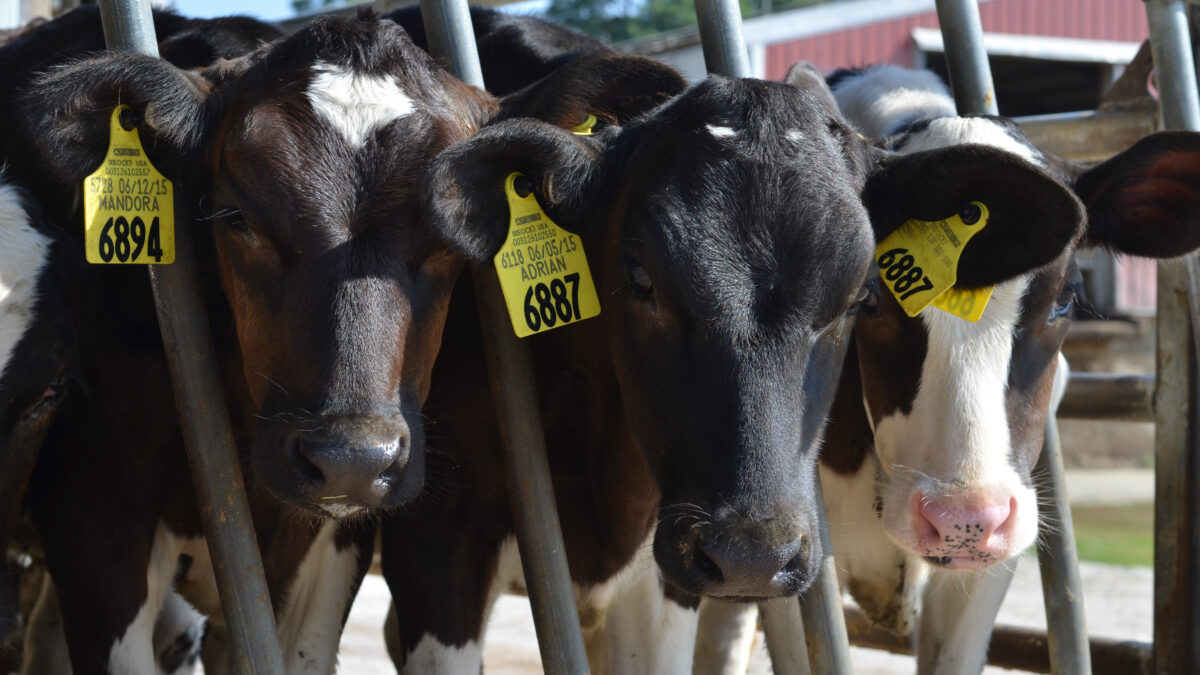
photo credit: New York Farm Bureau member Laura Audrey Hanehan
Michael Nepveux
Former AFBF Economist
The ripple effects of COVID-19 have been very damaging to dairy farmers. However, while the Dairy Margin Coverage program was helpful in the early months of the pandemic for producers who had elected to receive coverage, in recent months, many participating dairy producers have been without support. Due to a combination of time lags in the reporting of prices, negative producer price differentials, and dairy markets’ reaction to COVID-19 and other government support programs, USDA’s Farm Service Agency announced DMC did not make payments to any producers for the month of June and it likely will announce zero payments for July as well.
DMC Enrollment
DMC Enrollment for 2020 ran from early October 2019 to late December 2019. At 122 billion pounds, 2020 enrollment fell by approximately 60 billion pounds from 2019.
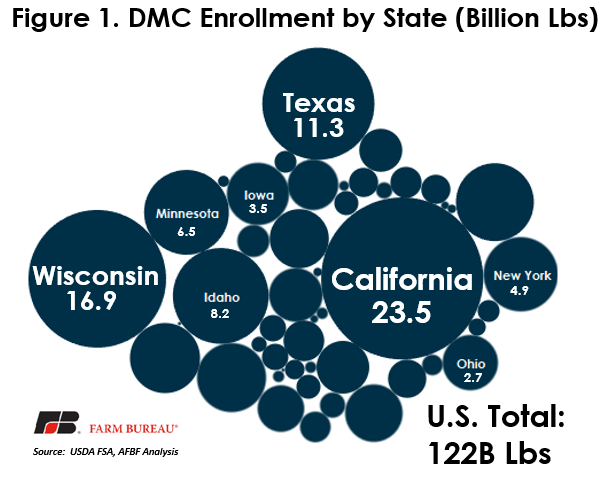
Largely driving the decline in enrollment was a brighter economic outlook for dairy for the coming year. When forecasting the income-over-feed-cost margin at the end of 2019, the all milk price in 2020 was expected to remain well above 2016-2019 levels, averaging over $19/cwt, compared to prices mostly hovering in the $15-$17 range since 2016. Figure 2 shows a forecast of the all milk price calculated in early January, as well as the all milk price required to trigger a payment at the $9.50 coverage level. Before COVID-19 disrupted our daily life, 2020 was anticipated to be a bright year for dairy prices and there was low probability of a payment from DMC.
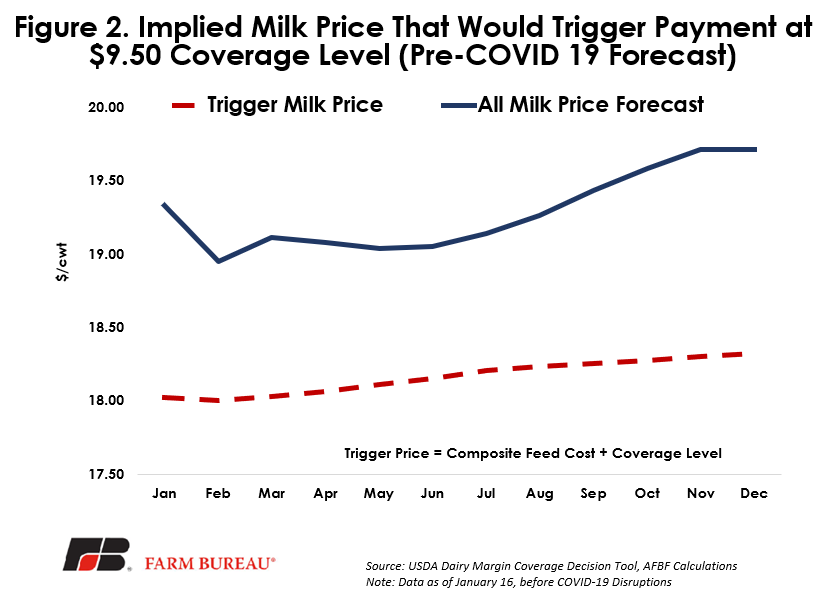
DMC Payments So Far
Eight months into the year, we know this rosy January forecast never came to pass. Instead, we saw months of disruptions to the dairy industry as entire sectors of our economy shut down. Producers who were enrolled in DMC received somewhat of a reprieve via payments made the first few months of the pandemic. As of the end of July, DMC has made an estimated $196 million in payments to producers enrolled in the program.
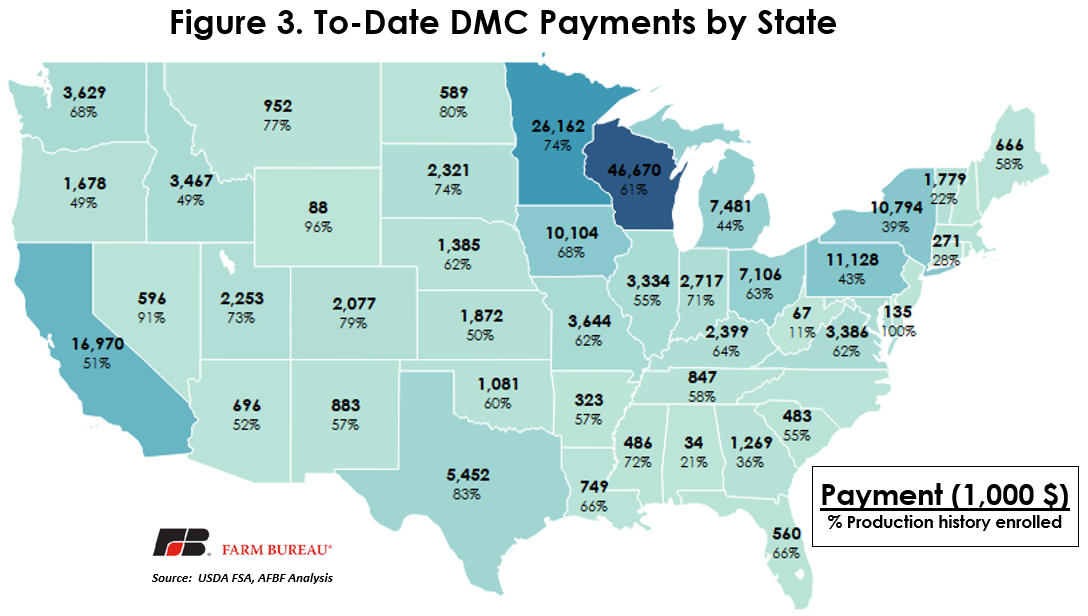
Wisconsin leads the country in estimated payments, receiving almost $47 million. It is followed by Minnesota and California, where enrolled producers received $26 million and $17 million, respectively. It is interesting that Wisconsin and Minnesota have received greater payments than California considering they have enrolled less milk than California. This implies that these two states have a greater number of smaller dairies that were able to enroll their first 5 million pounds of milk at a higher coverage under Tier I, while California likely had a significant share of its covered milk enrolled at lower levels under Tier II coverage, for which a payment was not triggered. This view is reinforced when looking at the number of dairies enrolled in DMC for 2020: California only has 638 dairies enrolled, while Minnesota has 1,900 operations in the program and 3,300 operations in Wisconsin elected to receive coverage.
Lack of DMC Payments in June
After three months of payments from DMC, USDA announced an income-over-feed-cost margin at $9.99 for the month of June, above the highest coverage level of $9.50, resulting in no payments under DMC. The higher income-over-feed-cost margin was largely due to a skyrocketing all milk price for the month, which shot up to $18.10/cwt from $14.40/cwt in April and $13.60/cwt in May. There may not be much hope for the rest of 2020 as Figure 4 shows USDA’s DMC decision tool’s forecasted margin for the rest of the year remaining above $9.50. Granted, it’s not substantially above $9.50, and there still remains a 33%-46% probability that it falls below $9.50 and triggers a payment.
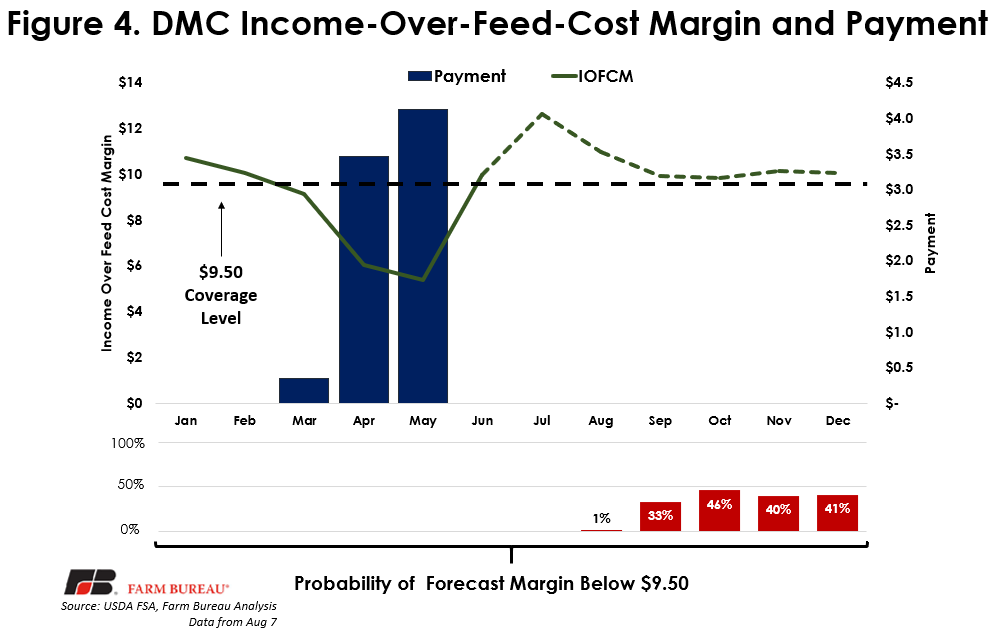
Typically, we would welcome news of rising milk prices and declining DMC payments as that would normally indicate improved market conditions. However, many dairy farmers did not see the benefit of rising prices due to negative producer price differentials. In multiple component pricing orders, proceeds from the pool are based on the difference between the classified value of the milk and the component value of the milk. When the component value of the milk exceeds the classified value of the milk, the proceeds from the pool are negative and result in a negative producer price differential. More simply, when the Class III price exceeds the Class I price, the PPD is expected to be negative. Handlers and cooperatives with a high Class III utilization may use the higher Class III proceeds to shield their producers from the negative PPDs. Handlers and cooperatives without a high utilization of Class III milk will likely pass along much of the negative PPD to producers through milk check deductions or adjustments to the component values, i.e., lower butterfat and protein prices.
There are some predominant factors that led to the current negative PPD situation. First, COVID-19-related price volatility resulted in a sharp decline in milk prices beginning in March, followed by a rapid increase in spot cheese prices in early May. Given the two-week lag from the Chicago Mercantile Exchange spot market prices to USDA’s National Dairy Products Sales Report prices and the nature of advanced pricing (Class I prices are announced one month in advance), the June Class I milk price was established using late-April and early-May spot market prices for cheese, butter, dry whey and nonfat dry milk. This means that the market lows experienced in late April – six weeks ago – were used to price fluid milk in June.
Summary
After three months of payments from DMC, USDA announced an income-over-feed-cost margin at $9.99 for the month of June, above the highest coverage level of $9.50, resulting in no payment under DMC. Typically, we would welcome news of rising milk prices and declining DMC payments as this normally indicates improved market conditions. However, the timing of this lack of payment hurts many dairy farmers who did not see the benefit of rising prices due to negative producer price differentials. Looking ahead, it is highly likely there will be no DMC payments in July, a disappointing development as the July Class I milk price has already been announced at $16.56 per hundredweight, which is below the current Class III value of $24 per hundredweight. This would also result in large negative PPDs for July, at the same time producers enrolled in DMC will go without payments.
Top Issues
VIEW ALL